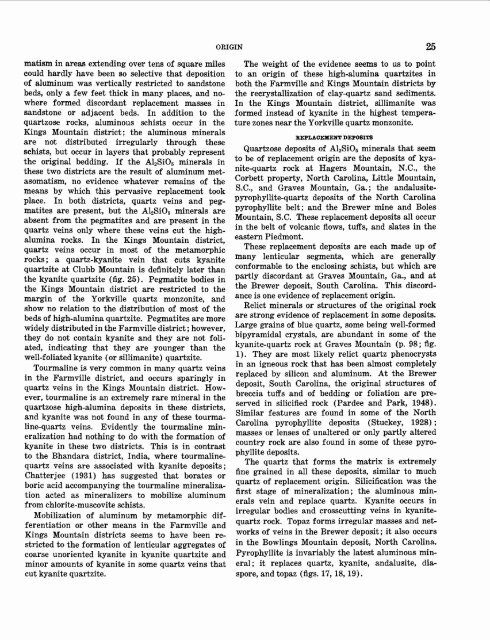Kyanite, Sillimanite, and Andalusite Deposits of the Southeastern ...
Kyanite, Sillimanite, and Andalusite Deposits of the Southeastern ...
Kyanite, Sillimanite, and Andalusite Deposits of the Southeastern ...
Create successful ePaper yourself
Turn your PDF publications into a flip-book with our unique Google optimized e-Paper software.
ORIGIN 25<br />
matism in areas extending over tens <strong>of</strong> square miles<br />
could hardly have been so selective that deposition<br />
<strong>of</strong> aluminum was vertically restricted to s<strong>and</strong>stone<br />
beds, only a few feet thick in many places, <strong>and</strong> nowhere<br />
formed discordant replacement masses in<br />
s<strong>and</strong>stone or adjacent beds. In addition to <strong>the</strong><br />
quartzose rocks, aluminous schists occur in <strong>the</strong><br />
Kings Mountain district; <strong>the</strong> aluminous minerals<br />
are not distributed irregularly through <strong>the</strong>se<br />
schists, but occur in layers that probably represent<br />
<strong>the</strong> original bedding. If <strong>the</strong> Al2Si0 5 minerals in<br />
<strong>the</strong>se two districts are <strong>the</strong> result <strong>of</strong> aluminum metasomatism,<br />
no evidence whatever remains <strong>of</strong> <strong>the</strong><br />
means by which this pervasive replacement took<br />
place. In both districts, quartz veins <strong>and</strong> peg<br />
matites are present, but <strong>the</strong> Al2Si0 5 minerals are<br />
absent from <strong>the</strong> pegmatites <strong>and</strong> are present in <strong>the</strong><br />
quartz veins only where <strong>the</strong>se veins cut <strong>the</strong> highalumina<br />
rocks. In <strong>the</strong> Kings Mountain district,<br />
quartz veins occur in most <strong>of</strong> <strong>the</strong> metamorphic<br />
rocks; a quartz-kyanite vein that cuts kyanite<br />
quartzite at Clubb Mountain is definitely later than<br />
<strong>the</strong> kyanite quartzite (fig. 25). Pegmatite bodies in<br />
<strong>the</strong> Kings Mountain district are restricted to <strong>the</strong><br />
margin <strong>of</strong> <strong>the</strong> Yorkville quartz monzonite, <strong>and</strong><br />
show no relation to <strong>the</strong> distribution <strong>of</strong> most <strong>of</strong> <strong>the</strong><br />
beds <strong>of</strong> high-alumina quartzite. Pegmatites are more<br />
widely distributed in <strong>the</strong> Farmville district; however,<br />
<strong>the</strong>y do not contain kyanite <strong>and</strong> <strong>the</strong>y are not foliated,<br />
indicating that <strong>the</strong>y are younger than <strong>the</strong><br />
well-foliated kyanite (or sillimanite) quartzite.<br />
Tourmaline is very common in many quartz veins<br />
in <strong>the</strong> Farmville district, <strong>and</strong> occurs sparingly in<br />
quartz veins in <strong>the</strong> Kings Mountain district. However,<br />
tourmaline is an extremely rare mineral in <strong>the</strong><br />
quartzose high-alumina deposits in <strong>the</strong>se districts,<br />
<strong>and</strong> kyanite was not found in any <strong>of</strong> <strong>the</strong>se tourmaline-quartz<br />
veins. Evidently <strong>the</strong> tourmaline mineralization<br />
had nothing to do with <strong>the</strong> formation <strong>of</strong><br />
kyanite in <strong>the</strong>se two districts. This is in contrast<br />
to <strong>the</strong> Bh<strong>and</strong>ara district, India, where tourmalinequartz<br />
veins are associated with kyanite deposits;<br />
Chatterjee (1931) has suggested that borates or<br />
boric acid accompanying <strong>the</strong> tourmaline mineralization<br />
acted as mineralizers to mobilize aluminum<br />
from chlorite-muscovite schists.<br />
Mobilization <strong>of</strong> aluminum by metamorphic differentiation<br />
or o<strong>the</strong>r means in <strong>the</strong> Farmville <strong>and</strong><br />
Kings Mountain districts seems to have been restricted<br />
to <strong>the</strong> formation <strong>of</strong> lenticular aggregates <strong>of</strong><br />
coarse unoriented kyanite in kyanite quartzite <strong>and</strong><br />
minor amounts <strong>of</strong> kyanite in some quartz veins that<br />
cut kyanite quartzite.<br />
The weight <strong>of</strong> <strong>the</strong> evidence seems to us to point<br />
to an origin <strong>of</strong> <strong>the</strong>se high-alumina quartzites in<br />
both <strong>the</strong> Farmville <strong>and</strong> Kings Mountain districts by<br />
<strong>the</strong> recrystallization <strong>of</strong> clay-quartz s<strong>and</strong> sediments.<br />
In <strong>the</strong> Kings Mountain district, sillimanite was<br />
formed instead <strong>of</strong> kyanite in <strong>the</strong> highest temperature<br />
zones near <strong>the</strong> Yorkville quartz monzonite.<br />
REPLACEMENT DEPOSITS<br />
Quartzose deposits <strong>of</strong> Al2Si0 5 minerals that seem<br />
to be <strong>of</strong> replacement origin are <strong>the</strong> deposits <strong>of</strong> kyanite-quartz<br />
rock at Hagers Mountain, N.C., <strong>the</strong><br />
Corbett property, North Carolina, Little Mountain,<br />
S.C., <strong>and</strong> Graves Mountain, Ga.; <strong>the</strong> <strong>and</strong>alusitepyrophyllite-quartz<br />
deposits <strong>of</strong> <strong>the</strong> North Carolina<br />
pyrophyllite belt; <strong>and</strong> <strong>the</strong> Brewer mine <strong>and</strong> Boles<br />
Mountain, S.C. These replacement deposits all occur<br />
in <strong>the</strong> belt <strong>of</strong> volcanic flows, tuffs, <strong>and</strong> slates in <strong>the</strong><br />
eastern Piedmont.<br />
These replacement deposits are each made up <strong>of</strong><br />
many lenticular segments, which are generally<br />
conformable to <strong>the</strong> enclosing schists, but which are<br />
partly discordant at Graves Mountain, Ga., <strong>and</strong> at<br />
<strong>the</strong> Brewer deposit, South Carolina. This discordance<br />
is one evidence <strong>of</strong> replacement origin.<br />
Relict minerals or structures <strong>of</strong> <strong>the</strong> original rock<br />
are strong evidence <strong>of</strong> replacement in some deposits.<br />
Large grains <strong>of</strong> blue quartz, some being well-formed<br />
bipyramidal crystals, are abundant in some <strong>of</strong> <strong>the</strong><br />
kyanite-quartz rock at Graves Mountain (p. 98; fig.<br />
1). They are most likely relict quartz phenocrysts<br />
in an igneous rock that has been almost completely<br />
replaced by silicon <strong>and</strong> aluminum. At <strong>the</strong> Brewer<br />
deposit, South Carolina, <strong>the</strong> original structures <strong>of</strong><br />
breccia tuffs <strong>and</strong> <strong>of</strong> bedding or foliation are preserved<br />
in silicified rock (Pardee <strong>and</strong> Park, 1948).<br />
Similar features are found in some <strong>of</strong> <strong>the</strong> North<br />
Carolina pyrophyllite deposits (Stuckey, 1928);<br />
masses or lenses <strong>of</strong> unaltered or only partly altered<br />
country rock are also found in some <strong>of</strong> <strong>the</strong>se pyrophyllite<br />
deposits.<br />
The quartz that forms <strong>the</strong> matrix is extremely<br />
fine grained in all <strong>the</strong>se deposits, similar to much<br />
quartz <strong>of</strong> replacement origin. Silicification was <strong>the</strong><br />
first stage <strong>of</strong> mineralization; <strong>the</strong> aluminous minerals<br />
vein <strong>and</strong> replace quartz. <strong>Kyanite</strong> occurs in<br />
irregular bodies <strong>and</strong> crosscutting veins in kyanitequartz<br />
rock. Topaz forms irregular masses <strong>and</strong> networks<br />
<strong>of</strong> veins in <strong>the</strong> Brewer deposit; it also occurs<br />
in <strong>the</strong> Bowlings Mountain deposit, North Carolina.<br />
Pyrophyllite is invariably <strong>the</strong> latest aluminous mineral;<br />
it replaces quartz, kyanite, <strong>and</strong>alusite, diaspore,<br />
<strong>and</strong> topaz (figs. 17,18,19).
















